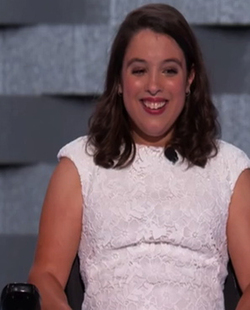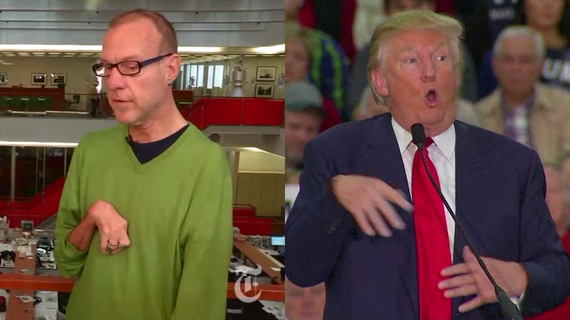Anastasia Somoza was on television last week, delivering the best speech you probably didn't see at the Democratic National Convention in Philadelphia.
It was an hour before broadcast network coverage started on Monday, Day One of the four-day event. Somoza was the 11th of 20 scheduled prime-time speakers, some of whom − Michelle Obama, Bernie Sanders, Cory Booker, Elizabeth Warren, Al Franken − were a tad better known than she.
The convention's disembodied program voice announced Somoza's name and hometown. The 32-year-old advocate for the rights of people with disabilities steered her powered wheelchair to the center of the vast stage and turned it to face the assembled thousands. She began to speak − with strength, heart, authority and authenticity.
Screen grabs of DNC feed
"I first met Hillary as First Lady on a visit to the White House," Somoza said. "I was 9 years old.... Over the past 23 years, she has continued to serve as a friend and mentor, championing my inclusion and access to classrooms, higher education and the workforce."
Somoza devoted about three-quarters of her five-minute speech to the enduring personal relationship that developed between her and Hillary Clinton after they met in 1993. Even back then, there was no missing the potential within the quietly assertive 9-year-old who, with her twin sister, Alba, had been born prematurely with cerebral palsy.
Today, Somoza said, Clinton "sees me as a strong woman, a young professional, a hard worker and a proud daughter of immigrants − my father from Nicaragua and my mother from Ireland." She praised the presidential nominee's depth of understanding of the challenges facing people with disabilities and how the whole country benefits when it helps them manage those challenges.
Somoza, a graduate of Georgetown University and the London School of Economics, closed by directly addressing the absent Clinton: "On the eve of the 26th anniversary of the Americans with Disabilities Act," she said, "I'm proud to be with you, Hillary. Thank you for showing me how to live boldly with a courageous heart."
The cheers of the standing crowd in the hall − applauding Somoza's inspiring presence as well as her eloquence − went on for nearly a minute. The young woman smiled broadly as she motored off stage, clearly pleased with the response and maybe a little surprised.
It was no surprise, however, given the heat of the presidential campaign, that much of the scant coverage of Somoza's guileless speech focused on a minute-long passage in the middle about Clinton's Republican opponent, Donald Trump.
"I fear the day we elect a president who defines being American in the narrowest possible terms," she said, "who shouts, bullies and profits off of vulnerable Americans.... I honestly feel bad for anyone with that much hate in their heart." Somoza expressed confidence that American voters in November would choose "genuine strength and thoughtful leadership over fear and division."
Somoza ended her brief comments on Trump by challenging a line he had used several times in his acceptance speech four days earlier: "I am your voice," he had told supporters.
"Donald Trump doesn't see me," Somoza countered, "he doesn't hear me, and he definitely doesn't speak for me."
Trump infamously pretended to speak for Serge Kovaleski, though. At a rally in Myrtle Beach, S.C., nine months ago, Trump flailed and bent his arms spastically and distorted his voice in ridiculing Kovaleski, a reporter for the New York Times who was born with arthrogryposis, a muscular disability that affects his joints and arm movements.
Serge Kovaleski, left, and Donald Trump. Photo illustration by CNN
As I and others wrote not long after, Trump's ignorant mockery of Kovaleski emerged in connection with a web of untruths in which the candidate had ensnared himself. Trump had told a false story claiming he saw TV coverage of thousands of Muslims in New Jersey celebrating when the World Trade Center buildings collapsed in the terrorist attacks of September 11, 2001. There was no evidence to support his tale.
Trump insisted that a 2001 story Kovaleski had written for the Washington Post backed up his fantasy about the New Jersey Muslims. Actually, the story did no such thing, which is what Kovaleski told other reporters who called to ask about Trump's claim.
For Trump, Kovaleski's honesty was enough to justify cruelly making fun of him, even though Trump denied that's what he was doing and denied that he'd ever met the reporter. In fact, Kovaleski had interviewed and covered Trump for years as a business writer for the New York Daily News.
Trump's ugly antics − not to mention his other bigotry-laced comments − earned him a deeply negative reputation among people with disabilities and those involved in advocacy work for them. The extraordinary Anastasia Somoza counts as both, and there is an extraordinary story, complete with video evidence, behind the initial visit to the White House she mentioned at the beginning of her speech.
The 9-year-old Somoza, it turns out, was one of a small number of students selected from some 20 elementary, middle and high schools − public and private − to participate in a two-hour Saturday morning ABC News special called President Clinton: Answering Children's Questions. The session, anchored by the late Peter Jennings, took place in the East Room of the White House and was broadcast on Feb. 20, 1993, just one month after President Bill Clinton's first inaguration.
Forty-nine minutes and 28 seconds into the program, Jennings called on Somoza, who proceeded to tell the president about a problem her family was having. She explained that her twin sister, Alba, could neither speak nor use her hands but communicated well by using a special computer.
Even so, Anastasia said, the school had refused their parents' request that Alba be allowed to join students in a regular classroom. It said she had to remain in a special classroom with students who could not communicate nearly so well. Anastasia wanted that to change.
Clinton replied that presidential influence over locally controlled schools was limited. But, he said, the fact the two of them had talked about the situation on television might get Alba a chance to show what she could do in a typical classroom setting. Anastasia listened carefully, responded clearly to all of Clinton's questions and expanded on her answers when she thought he hadn't quite grasped her point.
"Thanks for sticking up for your sister," the president said. "That's wonderful." Then he asked all the people in the East Room to join him in applauding her.
And what may be most remarkable of all, if you look into the eyes of 9-year-old Anastasia Somoza on this old video and listen to her quiet, confident voice, you get a clear sense of the qualities that this determined girl developed into the skills and talents of the 32-year-old woman who commanded the convention stage in Philadelphia last week.
A version of this column originally was published in print and online by the St. Louis Jewish Light.



